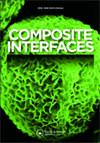透明电极用银和铜纳米线基纳米复合材料:沉积方法及其在太阳能电池中的应用
IF 2.4
4区 材料科学
Q3 MATERIALS SCIENCE, COMPOSITES
引用次数: 0
摘要
本文章由计算机程序翻译,如有差异,请以英文原文为准。
Silver and copper nanowire-based nanocomposite for transparent electrodes: deposition methods and applications in solar cells
ABSTRACT The solution-phase fabrication of photovoltaic cells has drawn a wide attention in the area of flexible electronics owing to their cost-effective and easy fabrication methodology. In addition to the different other layers, the transparent conducting layers have demonstrated a very important role in the fabrication of various flexible devices such as display panel, organic light-emitting diodes, and transparent heater. The most commonly used material for transparent electrodes (TEs) are indium tin oxide (ITO), aluminium zinc oxides (AZO), which required highly expensive vacuum-based harsh deposition methods. To reduce the overall fabrication cost of the thin film solar cells, researcher have devoted great efforts to replace the expensive ITO/AZO by applying silver nanowire (AgNW) or copper nanowire (CuNW)-based nanocomposite as TEs in photovoltaic cells. The emphasis is given on the deposition techniques so that the nanowire-based composite electrode can be deliberately prepared by surface engineering for desired applications. The utilization of AgNW or CuNW-based nanocomposite prepared by different methods of deposition have been explored in the field of photovoltaics as TE. The exhaustive analysis on the deposition methods to prepare nanowire-based TE will benefit the researcher to further achieve new advancement in the field of flexible electronics.
求助全文
通过发布文献求助,成功后即可免费获取论文全文。
去求助
来源期刊

Composite Interfaces
工程技术-材料科学:复合
CiteScore
5.00
自引率
3.80%
发文量
58
审稿时长
3 months
期刊介绍:
Composite Interfaces publishes interdisciplinary scientific and engineering research articles on composite interfaces/interphases and their related phenomena. Presenting new concepts for the fundamental understanding of composite interface study, the journal balances interest in chemistry, physical properties, mechanical properties, molecular structures, characterization techniques and theories.
Composite Interfaces covers a wide range of topics including - but not restricted to:
-surface treatment of reinforcing fibers and fillers-
effect of interface structure on mechanical properties, physical properties, curing and rheology-
coupling agents-
synthesis of matrices designed to promote adhesion-
molecular and atomic characterization of interfaces-
interfacial morphology-
dynamic mechanical study of interphases-
interfacial compatibilization-
adsorption-
tribology-
composites with organic, inorganic and metallic materials-
composites applied to aerospace, automotive, appliances, electronics, construction, marine, optical and biomedical fields
 求助内容:
求助内容: 应助结果提醒方式:
应助结果提醒方式:


